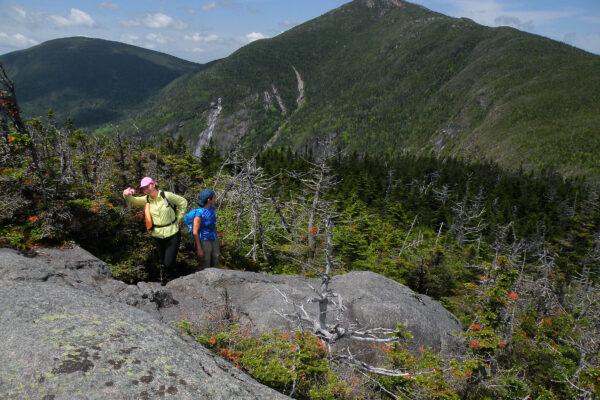Part 3 of 3
The High Peak of the Southern Adirondacks: A History of Crane Mountain
Part 1: The Lady of Crane Mountain
Part 2: The Paint Mine and the Tower
Part 3: Paul Schaefer’s Winter Ascent
Automobiles enabled a new generation of suburbanites from the Mohawk and Hudson valley regions to begin visiting the mountains more frequently. Some of these people acquired rustic cabins built by the early homesteaders and converted them into camps. Paul Schaefer, a contractor from Schenectady, was one such person. In 1926 he and his brother Vincent bought a century-old cabin in Bakers Mills and made it their base of operations; they bunked there at night, and explored the surrounding wilderness by day. The property happened to have a grand view of Crane Mountain across the valley to the southeast, and naturally they were drawn to its craggy heights. The mountain became one of Paul’s favorite places to climb.
In January 1931, after none of the local residents could recall anyone ever climbing Crane in winter, Schaefer resolved to become the first. He set off cross-country on bearpaw snowshoes, heading from Bakers Mills to the residence of Elliot Putnam, the son of Francis Putnam and the inheritor of the family farm at the foot of the mountain where the most popular trails to the summit began. Putnam tried to talk him out of climbing the mountain in favor of staying at his place overnight, but Schaefer, only twenty-two years old at the time, was too determined to be dissuaded.
Starting late in the afternoon, he scaled the steep and narrow trail to the pond and attempted to camp overnight on its shore. He fell asleep contented under the clear night sky, but when his fire died out and frost began to coat his fur-lined sleeping bag, he decided to begin his final ascent of the summit at 1 o’clock in the morning—the exertion would help him keep warm, he reasoned. His climb was aided by brilliant moonlight, and even at night he was able to see for miles when he reached the foot of the fire tower at the top. He completed his night’s rest in the nearby observer’s shelter, and enjoyed the full glory of the view when the sun rose. Later that day he glissaded off the mountain, exalted in his accomplishments.

In 1933, all three Schaefer brothers—Vincent, Carl, and Paul—camped at nearby Round Pond with other members of the Mohawk Valley Hikers while scouting a route for Vincent’s proposed Long Path, which he had proposed as a 400-mile hiking trail intended to connect Manhattan with Lake Placid. The Schenectady Gazette described their first idyllic night out:
Saturday afternoon found the camp established on Stony Point with the cook fire near the tip of the point and the shelters scattered here and there in the woods nearby. After a hearty supper, a song fest continued until the moon was high overhead. A canoe toted two miles over a mountain [trail] by Carl Schaefer added greatly to the enjoyment of the evening.
The Stony Point campsite made such a favorable impression on Vincent Schaefer that he endorsed the pond highly in subsequent Long Path route descriptions. “Round Pond is quite wild and very beautiful,” he said. “Its many coves, sand beaches, abundant wild life and huge pike make it an ideal place to tarry a while if time permits.”

Over the middle decades of the twentieth century Paul Schaefer became one of the most effective leaders of the Adirondack conservation movement, celebrated today for his pitched battles against the proposed dam construction projects on the Moose and Hudson rivers. One of the people who contributed money to his campaigns was Jeanne Robert Foster, who had moved to Schenectady in 1932, where few were aware of her storied past. Foster and Schaefer began to correspond for a few years beginning in 1968, discovering their shared love of Crane Mountain. Foster died in 1970 at age ninety-one, but among her final poems was one entitled “Crane Mountain (for Paul Schaefer),” in which she seemed to be ceding title to her favorite place to a kindred spirit. Schaefer died in 1996; he is now commemorated with a plaque located near the foot of the mountain alongside the Putnam Trail, the route that he had followed decades before on his winter ascent.

If there is any place in the southern Adirondacks that should be targeted for acquisition, it is the forest surrounding the feet of Crane and Huckleberry mountains; the entire area between Thurman and Garnet Lake Road constitutes and outstanding “pocket wilderness” that should be further preserved. In 2021, New York State and the Open Space Institute did complete a land transaction that added most of Huckleberry Mountain and a longer portion of Crystal Brook to the Forest Preserve, but even with this significant addition there are still several large gaps in the combined parcel that would be worth filling.
Nevertheless, what the public does own is nothing short of outstanding—Crane Mountain is easily one of the most enjoyable peaks in the entire Adirondack Park. The trails that hikers climb today are essentially the same as those followed by Foster and Schaefer. They scale some of the steepest slopes on the mountain, which rise imposingly above you as you drive toward them—but this steepness has always been a part of the Crane experience. The terrain is rugged, but the miles are short, and so all of the best features remain within reach for many people.



